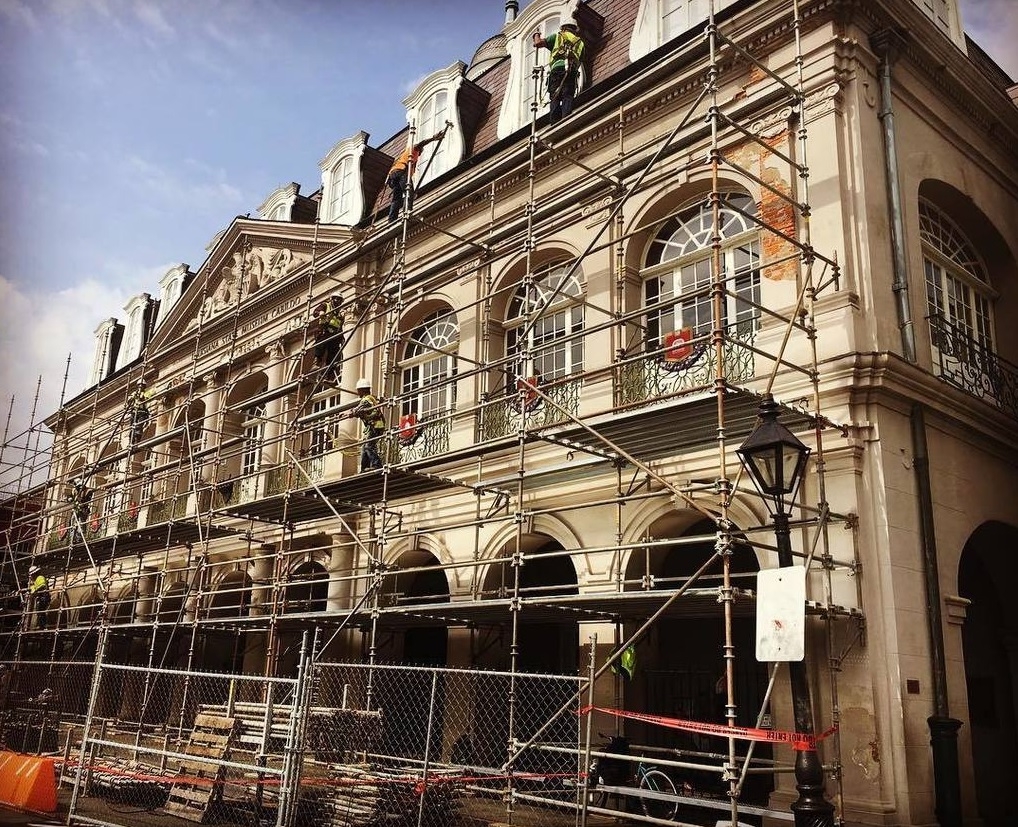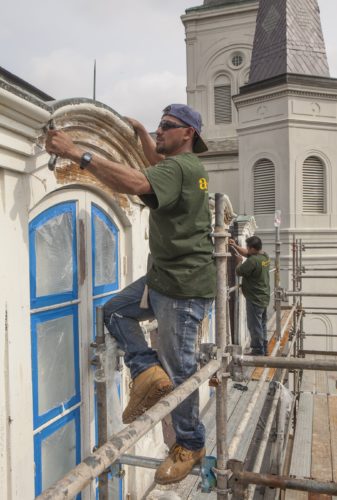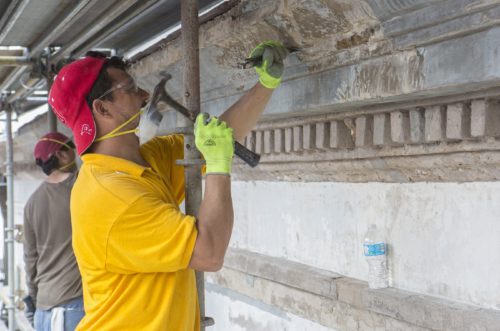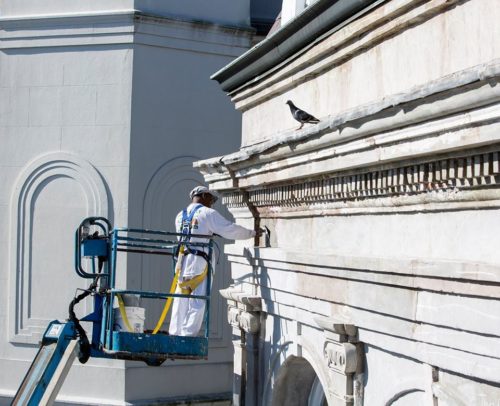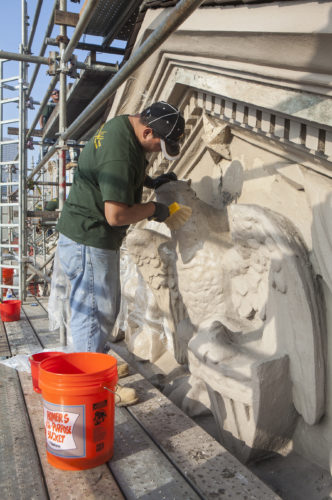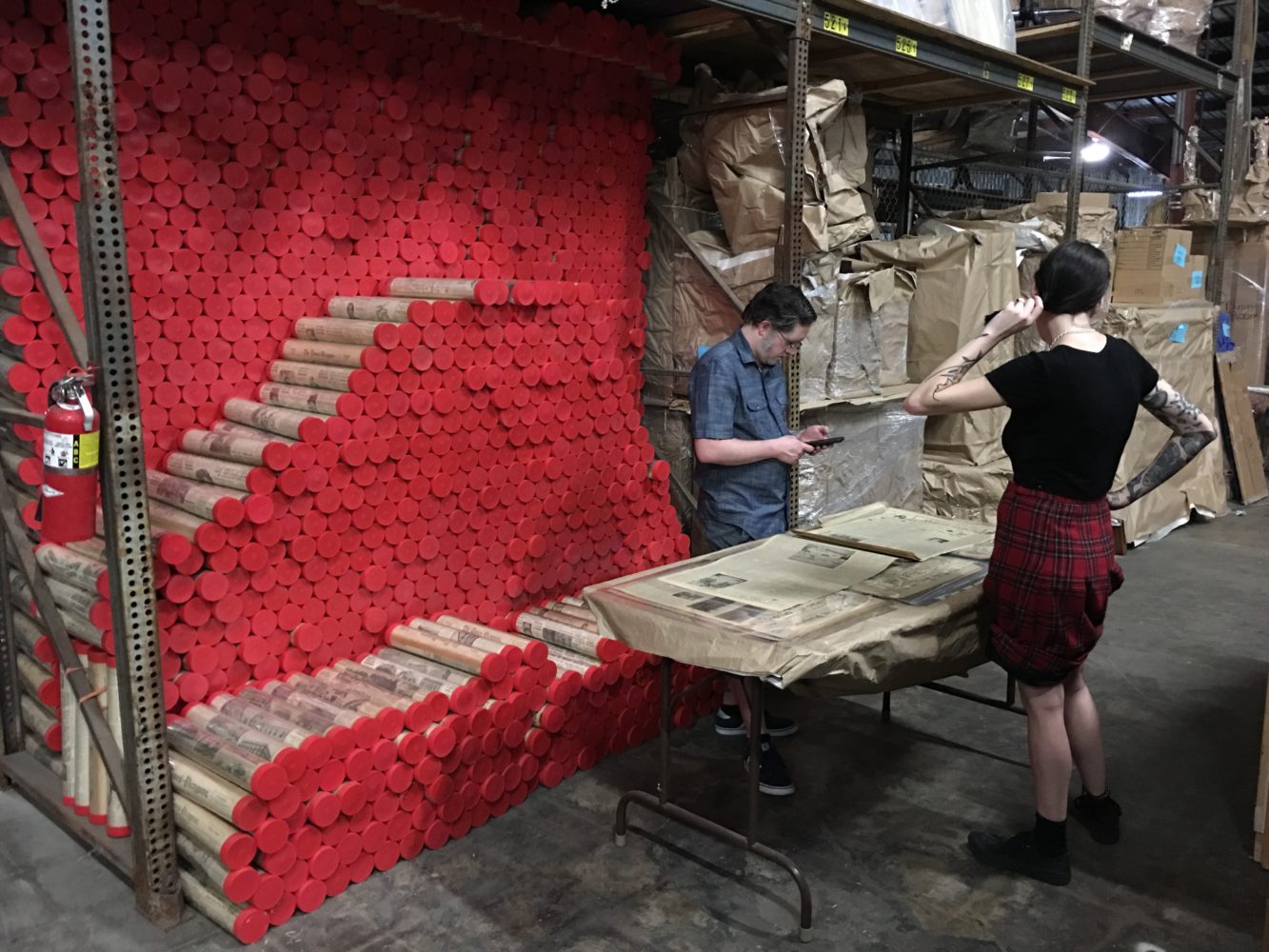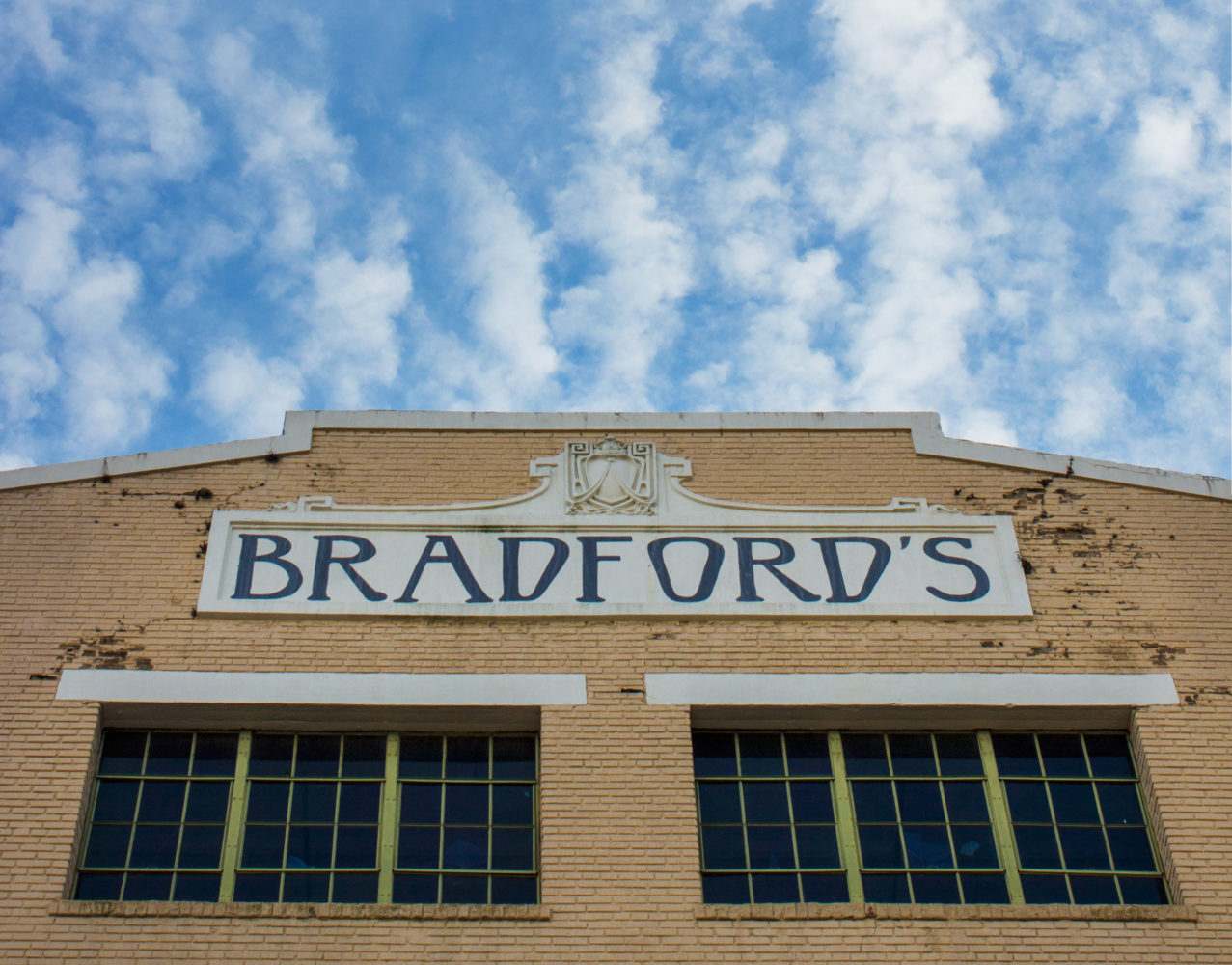This story first appeared in the February issue of the PRC’s Preservation in Print magazine. Interested in getting more preservation stories like this delivered to your door each month? Become a member of the PRC for a subscription!
If the restoration work on the Cabildo and the Presbytère teaches us anything about historic preservation, it is that progress is not always linear.
The latest round of renovations on these historic buildings began in February 2017, when Lt. Governor Billy Nungesser announced the need for $3.4 million worth of emergency repairs. This work was necessary to prevent plaster and stucco from “breaking off, falling to the street and posing a danger to the public and the artifacts inside,” Nungesser said. Ironically, this instability was the result of the application of an elastomeric coating applied to the Cabildo around 1998 and the Presbytère in 2004 — a coating that was intended to stabilize the buildings.
The Cabildo and the Presbytère, which flank St. Louis Cathedral on Jackson Square, are among the most recognizable historic buildings in Louisiana and, arguably, the nation. In his first design for the city of New Orleans, completed in 1721, French military engineer Adrien de Pauger featured a parish church at the town’s center, bordered by governmental offices on one side and a church rectory on the other.
The buildings that stand on these sites today were built after the Good Friday Fire of 1788, which destroyed their predecessors, along with much of the French Quarter. The day after the fire, Spanish official and philanthropist Don Andrés Almonester y Roxas volunteered to pay for the rebuilding of the Presbytère (then referred to as Casa Curial) and the cathedral. Architect and engineer Don Gilberto Guillemard, a native of France serving in the Spanish military, was quickly asked to draw plans for both.
In 1795, after yet another fire in December of the previous year, Almonester agreed to lend the city the money to complete the Cabildo as well. He insisted, however, that Guillemard’s plan for the Presbytère be used as the basis for its design.
While construction on the Cabildo proceeded at a relatively steady pace between 1795 and 1799, work on the Presbytère took a more circuitous route. Following Almonester’s death in April 1798, his widow refused to honor her husband’s commitment to continue work on the Presbytère, citing economic hardship. As a result of the litigation, the Presbytère remained an unfinished, one-story building until the wardens of St. Louis Cathedral hired a private contractor to finish the work in 1813.
Click to expand images. Photos courtesy Mark J. Sindler/Louisiana State Museum.
Before the Presbytère was completed, Louisiana was no longer a colony of Spain. On December 20, 1803, a ceremony at the Cabildo formalized the Louisiana Purchase, a transaction that effectively doubled the size of the United States and opened up the continent to its westward expansion. Despite the regime change, the Presbytère and Cabildo continued to serve as the center of New Orleans government for much of the antebellum period. Rather than shelter clergy, the Presbytère was used for commercial purposes until 1834, when it became home to several municipal courts. The Cabildo served as city hall from 1803 until 1852. The Louisiana Supreme Court called the Presbytère home between 1823 and 1853; it then relocated to the Cabildo, where it remained until 1910.
In the mid-19th century, the Cabildo and the Presbytère underwent major renovations, including the addition of a third story and a French-styled mansard roof on each building. These changes were inspired, in large part, by the arrival of Micaela Almonester, Baroness de Pontalba, in the late 1840s. Having lived much of her life in France, the Baroness returned to New Orleans with a plan to transform the dilapidated buildings she inherited from her father — who was none other than Don Andrés Almonester y Roxas — into elegant, Parisian-style rowhouse buildings, placed on each sides of the Place d’Armes. Those buildings are known today as the Upper and Lower Pontalba Buildings.
The Baroness’s plans proved extremely influential with New Orleanians, particularly Creoles, who were anxious to spruce up the older part of the city to compete with the rapidly developing American sector uptown.
While the addition of mansard roofs to the Cabildo and Presbytère was part of this broader effort to beautify the Place d’Armes, it was also an attempt to solve a practical problem. By all accounts, the flat roofs included in Guillemard’s original design for the buildings leaked like sieves. Reports of water intrusion in both buildings appeared as early as 1803, and by 1847, when the City approved the addition of the new roofs, the problem was widespread. A coat of brown stucco was also applied to both buildings in 1850, in the hopes that it would help them shed moisture more effectively. The use of stucco also reflected the popularity of brown-stone buildings during the 1850s, when the Italianate architectural style was in vogue.
Despite frequent lime washes and routine building maintenance, the Cabildo and Presbytère continued to be affected by leaks and moisture intrusion for years to come. In 1853, the city council moved its offices from the Cabildo to Gallier Hall, making the problem less visible but no less problematic. In an article in the April 19, 1891, Daily Picayune, the buildings, which still housed a number of courts, were described as “dark, damp and dingy,” as “relics of the olden days…altogether unsuited for the purposes to which they are devoted.”
Perhaps influenced by the broader urban renewal movement sweeping the nation, the city council proposed tearing both buildings down and replacing them with new structures in 1895. Public outcry put an end to the council’s plans and led to the city’s decision to transfer ownership of the buildings to the Louisiana State Museum in 1908.
Under the tenure of LSM, the Cabildo and Presbytère underwent several major and numerous minor renovations in the 20th century. In the 1930s, workers employed by the Works Progress Administration replaced rotting woodwork and flooring and repaired damage to the exterior walls and interior plaster, among other things.
In 1960, the Louisiana State Legislature approved an appropriation of $900,000 for repairs to the Cabildo and the Presbytère, the latter of which was apparently in particular dire shape. In a March 31, 1963, article in the Times-Picayune Dixie magazine, LSM business manager Charles Frampton indicated that one of Presbytère’s walls was “leaning eleven inches toward St. Ann’s Street” and in “danger of falling at any moment.” One of the building’s exterior walls had to be torn down and rebuilt. The building’s central staircase also was removed at this time.
Soon after this work was completed, Hurricane Betsy struck New Orleans on Sept. 9, 1965, damaging both buildings. In response, the legislature appropriated another $800,000 for repairs, most of which went toward work on the Cabildo. At that time, the firm of Maxwell and Le Breton, working with the firm of Richard Koch and Samuel Wilson, Jr., did extensive research on the building, including an archaeological excavation that proved that the walls of the French corps de garde or prison, built in 1751, survived the fires of 1788 and 1794 and had been incorporated into the extant Cabildo building.
This research led to the first full-scale restoration of the Cabildo between June 1967 and June 1969, when a team led by the C. B. Spencer Company worked to return the building to its circa-1799 appearance. They removed years of modifications and adaptations and added period lighting, windows and fireplaces. An exception was made on the first floor where a section of the 1751 floor of the corps de garde was left exposed.
The Cabildo and Presbytère remained relatively stable until May 1988, when a fire started by a welder’s soldering torch destroyed the Cabildo’s mansard roof and cupola. The building was closed to the public until 1994, while Koch and Wilson, directed by project architect and firm principal Robert Cangelosi, carefully reconstructed the damaged architectural features.
Click to expand images. Photos courtesy Mark J. Sindler/Louisiana State Museum.
Around the same time that the Cabildo was being restored, a new technique for waterproofing historic structures became increasingly popular: elastomeric paint. Because the application of a thick elastomeric coating could make buildings, especially those made of masonry and stucco, virtually waterproof, advocates of the product argued that historic structures could be protected more effectively than ever before. “The supposed properties of elastomeric were to repel water from the exterior,” architect Harvey Burns, principal of Jahncke & Burns Architects, said recently. “But this was not the case — the coating led to the acceleration of decay of the historic fabric.”
With the best of intentions, workers applied elastomeric coatings to the Cabildo around 1998 and the Presbytère in 2004. Around the same time, the Old Ursuline Convent in New Orleans and the Old State Capitol in Baton Rouge received similar applications. But what was first seen as a state-of-the-art technique soon turned out to be a preservationist’s nightmare. As it turns out, exterior masonry and stucco require a certain amount of moisture to maintain their structural integrity; without it, the exterior cracks and crumble.
“Elastomeric coats are designed to exclude water from buildings, and in theory they don’t cause problems as long as all water is excluded from entering a building. But that is impossible to do,” said Cangelosi. “Water can come from rising damp, hairline cracks, movement, interior sources including condensations, failure of adhesion of the stucco and other sources. And once in the moisture is in, it cannot escape, as the coating is designed to prevent the transmission of moisture.”
Trapped behind the paint, this moisture has no place to go except through the building’s interior plaster walls. But before this was realized, damage had been done. The Old Louisiana State Capitol building was one of the earliest buildings in Louisiana to report damage after it was discovered that the elastomeric coatings had been the culprit behind decay caused by trapped moisture within the building walls.
“Historic buildings and their fabric must be able to breathe,” Cangelosi said. “History has shown that any product which prevents that will have an adverse effect.”
Elastomeric coatings did not go from panacea to poison overnight, of course. But by 2005, the Vieux Carré Commission (VCC) rejected the Ursuline Convent’s request to repaint an elastomeric fence. Staff analysts concluded that such paints “are disastrously inappropriate for historic masonry walls and structures in all high humidity/high temperature climates and especially in sub-tropical and tropical climes like New Orleans.”
These words proved prophetic, and work to remove the elastomeric coatings on the Cabildo and the Presbytère began in 2014. By that point, the damage done to those buildings by the coatings was severe. “”I received a video early one morning from someone passing the Cabildo as parts of it literally were exploding off the building as the trapped moisture was trying to escape,” Cangelosi said. “Not only did it cause extensive damage to the building, but someone could have been seriously hurt.” Koch and Wilson Architects was selected to oversee the work of associated waterproofing at the Cabildo, and Jahncke & Burns Architects was chosen as the architect of record for the work of advanced waterproofing at the Presbytère. Associated Waterproofing is the contractor of work on the Cabildo, and Advance Waterproofing LLC served as general contractor for the Presbytère‘s first phase of work.
At first, the plan was to remove the coating from only the front façade of each building. As the work proceeded, however, it quickly became clear that not only would the other sides of the buildings need to be stripped, but that stucco and masonry underneath the elastomeric coatings had suffered extensive structural damage and would need repair.
It was this discovery that led to the Lieutenant Governor’s request for emergency funds from the state Interim Emergency Board in February 2017. After hearing the evidence, the board unanimously agreed to allocate $945,862 for the project. The Department of Culture, Recreation and Tourism, directed by Billy Nungesser, and the Office of Facility Planning and Control supplemented these funds with an additional $2.53 million from sources that included the Department’s annual budget for major repairs. The work should be completed in early 2018.
The price to restore these over 200-year-old buildings is undeniably steep, but the expenditure is, as Nungesser has stated, the only way to “ensure that Louisiana’s history, as exemplified in these structures, will be here for future generations to understand and to appreciate.”



